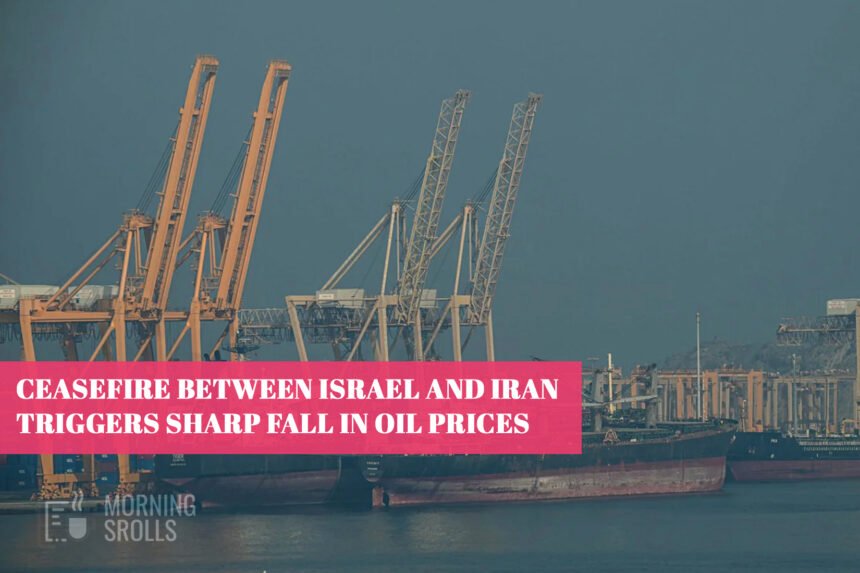Oil prices dropped sharply by about 5% on Tuesday after Israel confirmed it would join a ceasefire with Iran, ending nearly two weeks of fighting that had rattled global energy markets. The price of Brent crude, the main global oil benchmark, fell below $67 a barrel by the end of the day, though it regained some ground later in trading. This marked a significant turnaround after oil prices had surged as high as $81 a barrel during the height of the conflict, driven by fears that Iran might block the Strait of Hormuz—a vital route for global oil and gas shipments.
Ceasefire Announcement Eases Market Fears
Oil prices saw a steep decline immediately after President Donald Trump revealed that Israel and Iran had reached a comprehensive ceasefire agreement, brokered with U.S. assistance. Israel confirmed its participation in the truce, which helped calm worries about further disruptions to energy supplies from the Middle East—a region responsible for a significant share of the world’s oil and liquefied natural gas exports.
For days, oil markets had been on edge, with traders concerned that the conflict might escalate and threaten the steady flow of oil through the Strait of Hormuz, which handles about 30% of global oil trade and 20% of LNG shipments. However, those fears eased after Iran’s missile attacks, including one on a U.S. base in Qatar, were intercepted and did not target oil tankers or critical shipping lanes.
Oil Prices Reverse Course
Before the ceasefire, oil prices had climbed rapidly, with Brent crude reaching $79 a barrel on Sunday after the U.S. bombed Iranian nuclear facilities. The volatile market quickly reversed those gains after Iran’s response was limited and the ceasefire was announced. By Tuesday evening, Brent crude was trading around $66.21 per barrel, and U.S. West Texas Intermediate (WTI) crude dropped to $65.46 per barrel, its lowest level in over a week.
Industry analysts said the drop in prices reflected fading concerns about a major supply disruption. “The geopolitical premium is fading. Prices should now be guided primarily by supply and demand,” one market executive explained, adding that increased OPEC+ production and slower growth in demand would likely keep prices in check.
Stock Markets Rally on Ceasefire News
The ceasefire also brought relief to global stock markets. U.S. stocks climbed, with the Dow Jones Industrial Average rising by nearly 375 points, the S&P 500 up by 0.96%, and the Nasdaq Composite gaining 0.94%. European markets followed suit, with Germany’s DAX index jumping 1.6% and the UK’s FTSE 100 up by 0.5%. Asian markets also saw gains, with Japan’s Nikkei index closing 1.1% higher.

Investors were encouraged by the prospect of stability in the Middle East and the possibility that energy prices would not continue to surge. The drop in oil prices was seen as positive for businesses and consumers, as it could help prevent increases in the cost of living, including petrol, diesel, and other goods and services that depend on energy.
Gas Prices and Energy Costs Fall
The easing of tensions also led to a sharp drop in wholesale gas prices. In the UK, for example, wholesale gas prices fell by 17% on Tuesday after spiking earlier in the day. As a leading exporter of liquefied natural gas, Qatar relies heavily on the Strait of Hormuz for shipping; therefore, easing tensions in the area has brought stability to energy markets.
Conflict’s Impact on Markets
The recent conflict has caused oil prices to soar, raising concerns that higher energy costs would make everything from fuel and food to travel more expensive around the world. This is similar to what happened after Russia invaded Ukraine three years ago, when global energy prices spiked and affected people’s lives everywhere.
However, with the ceasefire in place and both Israel and Iran agreeing to halt attacks, markets are now shifting their focus back to fundamentals like OPEC’s production plans and global demand for oil and gas. Some analysts believe that if the ceasefire holds, oil prices could continue to fall, possibly dropping below $65 a barrel if the region remains calm.
Uncertainty Remains
Despite the positive reaction from markets, some doubts remain about how long the ceasefire will last. There were reports that Iran may have breached the truce by launching another missile strike, which caused oil prices to recover slightly from their lows. The extent to which both countries honor the ceasefire will play a key role in determining whether oil prices stay low or begin to climb again.
Oil prices fell sharply after Israel and Iran agreed to a U.S.-brokered ceasefire, bringing relief to energy markets and boosting global stock indices. The risk of a major supply disruption in the Middle East appears to have eased, at least for now. However, the situation remains fragile, and any renewed fighting could quickly send prices higher again. For the time being, businesses and consumers can expect some relief from rising energy costs, but the outlook depends on how well the ceasefire holds in the days to come.
MUST READ: G7 Summit 2025 in Canada: Key Highlights and India’s Role








